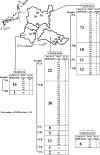Outbreaks of multidrug-resistant Pseudomonas aeruginosa in community hospitals in Japan
- PMID: 17122009
- PMCID: PMC1829129
- DOI: 10.1128/JCM.01772-06
Outbreaks of multidrug-resistant Pseudomonas aeruginosa in community hospitals in Japan
Abstract
We previously reported an outbreak in a neurosurgery ward of catheter-associated urinary tract infection with multidrug-resistant (MDR) Pseudomonas aeruginosa strain IMCJ2.S1, carrying the 6'-N-aminoglycoside acetyltransferase gene [aac(6')-Iae]. For further epidemiologic studies, 214 clinical isolates of MDR P. aeruginosa showing resistance to imipenem (MIC >or= 16 microg/ml), amikacin (MIC >or= 64 microg/ml), and ciprofloxacin (MIC >or= 4 microg/ml) were collected from 13 hospitals in the same prefecture in Japan. We also collected 70 clinical isolates of P. aeruginosa that were sensitive to one or more of these antibiotics and compared their characteristics with those of the MDR P. aeruginosa isolates. Of the 214 MDR P. aeruginosa isolates, 212 (99%) were serotype O11. We developed a loop-mediated isothermal amplification (LAMP) assay and a slide agglutination test for detection of the aac(6')-Iae gene and the AAC(6')-Iae protein, respectively. Of the 212 MDR P. aeruginosa isolates, 212 (100%) and 207 (98%) were positive in the LAMP assay and in the agglutination test, respectively. Mutations of gyrA and parC genes resulting in amino acid substitutions were detected in 213 of the 214 MDR P. aeruginosa isolates (99%). Of the 214 MDR P. aeruginosa isolates, 212 showed pulsed-field gel electrophoresis patterns with >or=70% similarity to that of IMCJ2.S1 and 83 showed a pattern identical to that of IMCJ2.S1, indicating that clonal expansion of MDR P. aeruginosa occurred in community hospitals in this area. The methods developed in this study to detect aac(6')-Iae were rapid and effective in diagnosing infections caused by various MDR P. aeruginosa clones.
Figures




Similar articles
-
Multidrug-resistant Pseudomonas aeruginosa strain that caused an outbreak in a neurosurgery ward and its aac(6')-Iae gene cassette encoding a novel aminoglycoside acetyltransferase.Antimicrob Agents Chemother. 2005 Sep;49(9):3734-42. doi: 10.1128/AAC.49.9.3734-3742.2005. Antimicrob Agents Chemother. 2005. PMID: 16127047 Free PMC article.
-
Emergence of a novel multidrug-resistant Pseudomonas aeruginosa strain producing IMP-type metallo-β-lactamases and AAC(6')-Iae in Japan.Int J Antimicrob Agents. 2012 Jun;39(6):518-21. doi: 10.1016/j.ijantimicag.2012.01.020. Epub 2012 Apr 5. Int J Antimicrob Agents. 2012. PMID: 22483560
-
Development of an immunochromatographic assay for the rapid detection of AAC(6')-Iae-producing multidrug-resistant Pseudomonas aeruginosa.J Antimicrob Chemother. 2010 Jul;65(7):1382-6. doi: 10.1093/jac/dkq148. Epub 2010 May 17. J Antimicrob Chemother. 2010. PMID: 20478990
-
Dissemination in Japan of multidrug-resistant Pseudomonas aeruginosa isolates producing IMP-type metallo-β-lactamases and AAC(6')-Iae/AAC(6')-Ib.J Infect Chemother. 2014 Sep;20(9):586-8. doi: 10.1016/j.jiac.2014.04.014. Epub 2014 Jun 6. J Infect Chemother. 2014. PMID: 24910373
-
Epidemiology of Multidrug-Resistant Pseudomonas aeruginosa in the Middle East and North Africa Region.mSphere. 2021 May 19;6(3):e00202-21. doi: 10.1128/mSphere.00202-21. mSphere. 2021. PMID: 34011686 Free PMC article. Review.
Cited by
-
Aloe vera Gel: Effective Therapeutic Agent against Multidrug-Resistant Pseudomonas aeruginosa Isolates Recovered from Burn Wound Infections.Chemother Res Pract. 2015;2015:639806. doi: 10.1155/2015/639806. Epub 2015 Jul 22. Chemother Res Pract. 2015. PMID: 26266047 Free PMC article.
-
Comparative Genomic Analysis of Multi-Drug Resistant Pseudomonas aeruginosa Sequence Type 235 Isolated from Sudan.Microorganisms. 2023 May 29;11(6):1432. doi: 10.3390/microorganisms11061432. Microorganisms. 2023. PMID: 37374934 Free PMC article.
-
Antibacterial Properties of Nonwoven Wound Dressings Coated with Manuka Honey or Methylglyoxal.Materials (Basel). 2017 Aug 16;10(8):954. doi: 10.3390/ma10080954. Materials (Basel). 2017. PMID: 28813014 Free PMC article.
-
Evaluation of multidrug efflux pump inhibitors by a new method using microfluidic channels.PLoS One. 2011 Apr 12;6(4):e18547. doi: 10.1371/journal.pone.0018547. PLoS One. 2011. PMID: 21533264 Free PMC article.
-
aac(6')-Iaq, a novel aminoglycoside acetyltransferase gene identified from an animal isolate Brucella intermedia DW0551.Front Cell Infect Microbiol. 2025 Mar 11;15:1551240. doi: 10.3389/fcimb.2025.1551240. eCollection 2025. Front Cell Infect Microbiol. 2025. PMID: 40134786 Free PMC article.
References
-
- Akasaka, T., M. Tanaka, A. Yamaguchi, and K. Sato. 2001. Type II topoisomerase mutations in fluoroquinolone-resistant clinical strains of Pseudomonas aeruginosa isolated in 1998 and 1999: role of target enzyme in mechanism of fluoroquinolone resistance. Antimicrob. Agents Chemother. 45:2263-2268. - PMC - PubMed
-
- Bingen, E., S. Bonacorsi, P. Rohrlich, M. Duval, S. Lhopital, N. Brahimi, E. Vilmer, and R. V. Goering. 1996. Molecular epidemiology provides evidence of genotypic heterogeneity of multidrug-resistant Pseudomonas aeruginosa serotype O:12 outbreak isolates from a pediatric hospital. J. Clin. Microbiol. 34:3226-3229. - PMC - PubMed
-
- Clinical and Laboratory Standards Institute. 2006. Methods for dilution antimicrobial susceptibility tests for bacteria that grow aerobically, 6th ed. Approved standard M07-A7. Clinical and Laboratory Standards Institute, Wayne, PA.
Publication types
MeSH terms
Substances
LinkOut - more resources
Full Text Sources
Other Literature Sources

